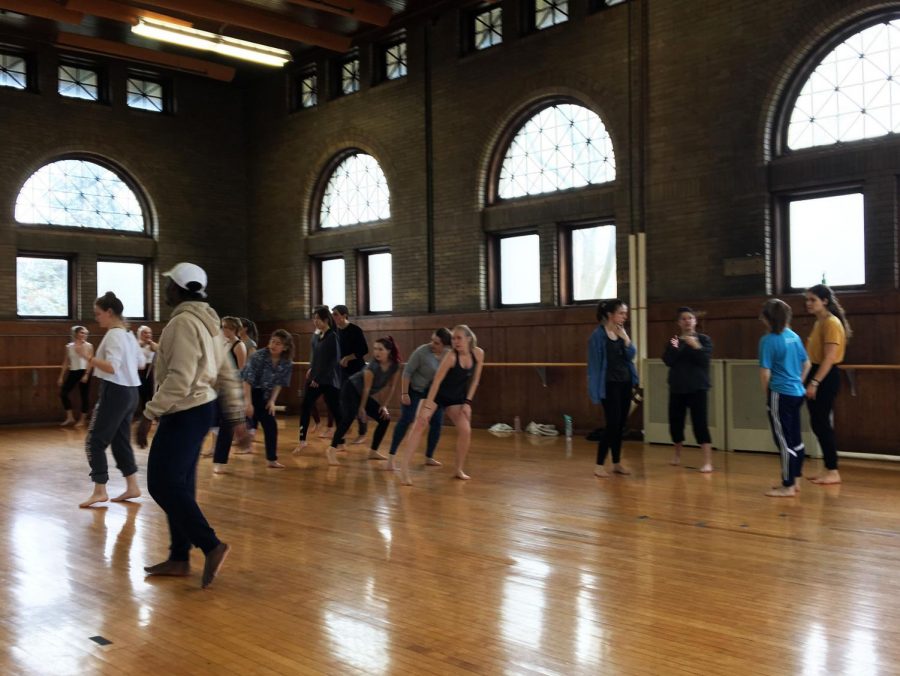Ohio 5 Dance Conference Returns to Oberlin, Builds Community
Courtesy of Ann Cooper Albright
Students and instructors take a class in Warner Dance Studio as part of this year’s Ohio 5 Dance Conference, hosted by Oberlin College.
Now in its sixth year, the annual Ohio 5 Dance Conference returned to Oberlin last Saturday for the first time since its inception. The event, which 78 people attended, brought together dance students and faculty from the Five Colleges of Ohio, a consortium of liberal arts schools that includes Kenyon College, Denison University, Ohio Wesleyan University, and The College of Wooster. The conference has proven to be an invaluable opportunity for faculty and staff to share their knowledge and form a community.
The day started with a big group warm-up before people split into their classes. Students were able to choose between three different workshops for each of the two class periods, and in both periods one of the three workshops was student-taught — a new addition this year. Students taught a hip-hop class in the morning and contact improv in the afternoon; other classes offered included Flamenco, African dance, Feldenkrais, and pilates.
Ann Cooper Albright, chair of the Dance department, spoke about how beneficial this conference is for Oberlin students.
“Because we had a lot of visiting professors, we were able to call on them to teach classes that don’t normally get taught,” Albright said.
Student Dance department representatives Kierra Nguyen, a junior Dance and Studio Art major, and Celia Morris, a senior Dance and Comparative American Studies major, both played a role in organizing this conference.
Morris talked about the African Dance class that she and Nguyen took with a Denison professor during the conference.
“We’re both in a contemporary class pretty regularly, and I was just craving something a little different,” she said. “I really appreciated that the teacher went back and forth with tracing the genealogy of the movements that she was teaching us and also asking us to bring ourselves into the movement. It was also traditional African dance, and then there was a lot of funk and groove that was built in there, and she really made it a collaboration and a conversation with the musicians.”
Nguyen also spoke about her experience with the visiting professors and students.
“You get the opportunity to not only see and learn from watching the people from other schools and how they move — and that influences how you move in return — but also the pedagogical practices of different professors,” she explained.
“Another thing that I really appreciated about the classes is that professors also take the class with you,” Nguyen added. “It was really great to be moving alongside your teachers.”
After classes ended, an informal showing was held where participants could share what they learned in classes that day. The showing was followed by a conference-wide contact improv jam, accompanied by live music.
Albright said that the final jam was one of her favorite parts of the event.
“The faculty just went out and made work,” she said. “They went right out and started dancing in a way that was actually creating performance right in front of us, it was great.”
The Ohio 5 Conference has historically been a valuable opportunity for Oberlin students to connect with people outside of their college bubble. Oberlin has sent students to the American College Dance Festival, but that conference has a lot of competitive energy and involves a greater financial expense. The Ohio 5 Conference is designed to provide a collaborative and supportive environment, and it’s funded by the Ohio Five Consortium.
Morris explained that the visiting students brought great energy to the conference.
“They just entered the space with a lot of generosity. With new bodies in the big Warner Main Space we had a lot of room to move, but also we came in contact with each other. We warmed up with everyone in the same space. Being able to pass by, you say hello.”
The conference has also allowed schools to develop networks and form communities that continue to grow through supplementary meetups and collaborations.
“I think it’s really great to see what other programs are doing,” Albright said. “The other thing that happens, because I teach contact improvisation, and we have open jams all the time [is that] we’ll invite people from Ohio 5 and they might come up and join us. Having those exchanges is super healthy for everyone.”
She also spoke about how useful this conference has been to her as a professor. “It’s great for faculty, because it’s about advocacy and ‘How’s dance doing in your neck of the woods?’ ‘Oh this is what we’re fighting for, this is what we’re working with.’ And we can share resources. [For example,] sometimes if we have visiting artists or something like that, they’ll go to more than one campus.”
Each year the conference moves to a different college, and for many students it has affirmed their love of the Oberlin Dance department.
“I always end up leaving these conferences really appreciative of Oberlin and what Oberlin has to offer,” Morris said. “We offer a pretty wide range of classes and styles, and we almost always are the school presenting work at every conference, and that’s pretty special. I end up being a little proud Obie at the end.”











